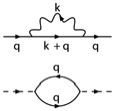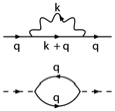Magnetoelastic coupling in iron superconductors
The members of the iron pnictide family based on and the iron chalcogenide , exhibit interwoven magnetic and structural transitions as a function of temperature. These transitions are suppressed and give way to superconductivity when the materials are doped or subjected to pressure. A standing mystery is the different wave vectors for the modulation of the experimentally observed antiferromagnetic orders in these systems. Given the similarity of the underlying electronic band structures, the observation of an antiferromagnetic order apparently incompatible with the Fermi surface topology in is not understood.
Now, in an article published in Physical Review Letters, Indranil Paul at the Institut Néel in Grenoble, France, presents a microscopic model that provides important clues about the underlying physics. In particular, he shows that quantum fluctuations induced by the coupling of magnetic and elastic degrees of freedom associated with the distortion of the crystal lattice within a two-dimensional metal cause the different modulation of the antiferromagnetic order in . In addition, he shows that similar effects lead to the observed orthorhombic structural transition in the vicinity of the magnetic ordering for the -based materials. – Alex Klironomos





